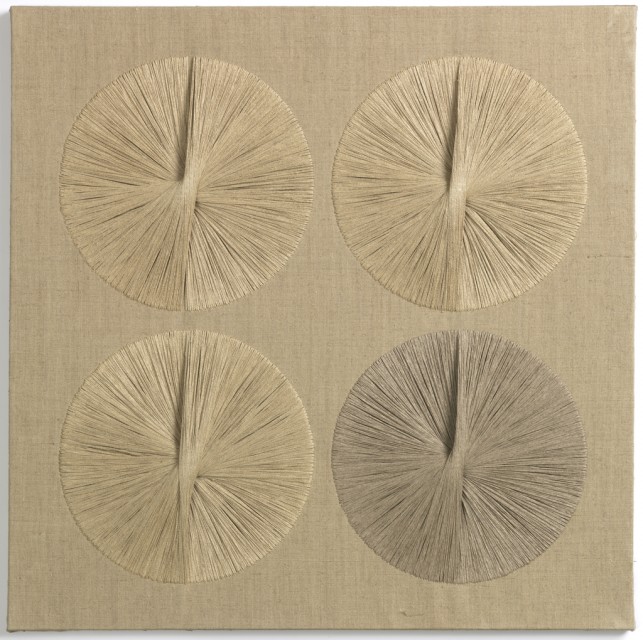The granite and glass Ford Foundation Headquarters Building on East 42nd Street in Manhattan was designed by Kevin Roche John Dinkeloo Associates. Completed in 1967, the building is an icon of International Style Modernism. New York Times critic Ada Louise Huxtable hailed the building, with its sky-lit atrium and lush indoor garden, as “12 stories of subtle splendor.”
This “subtle splendor” is reflected in the monochromatic, golden beige, seamless textile bas-relief wall panels developed through a collaboration between the building’s interior architect, Warren Platner, and the textile artist Sheila Hicks. The medallions of the installed wall panels are in a silk thread of same color as the linen background and were executed over anodized aluminum discs to maintain the tension in the embroidery. The wall panels’ medallions in straight rows and columns create a quiet rhythm of visual interest. As seen in the museum’s study sample, the orientation of the embroidered threads in each medallion is consistent, ensuring that each will capture and reflect light in the same way.
For Platner, the thread of the wall panels was not an ornament but rather a visible and complimentary construction material, giving rise to a “harmonious dialogue” with its surrounding elements. For Hicks, the project was the first time that a contemporary textile was conceived of as integral to the architectural space rather than merely a decorative ornament. It was “a real breakthrough,” she later said, “… a pliable plane that was then brought into tension and became the actual wall.”
Platner, a former associate of Eero Saarinen, was responsible for all aspects of the Ford Foundation Building’s interior, from the muted neutral color scheme to the custom-made, ergonomic, mahogany office furniture. Hicks was formally trained as a painter at Yale University’s School of Art, where she studied with Josef Albers. At Yale, she also gained an important understanding of architectural space by studying with architects Vincent Scully and Louis Kahn. As a result, her site-specific works, like the wall panels she collaborated on with Platner, fully integrate with their environments.
An in-depth retrospective of Hicks’s work is available at the Museum’s online shop: http://shop.cooperhewitt.org/p/2921/Sheila-Hicks-50-Years
